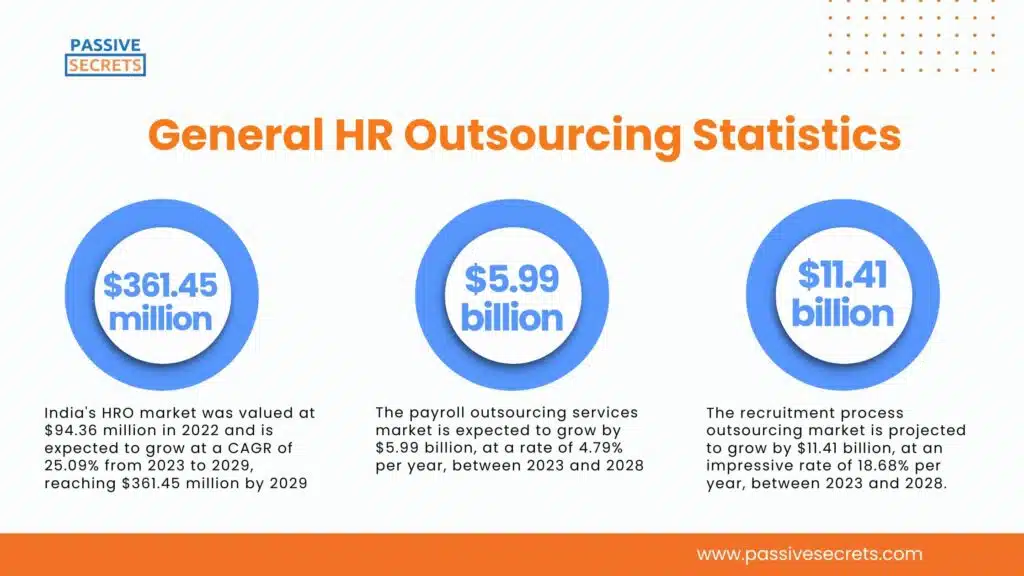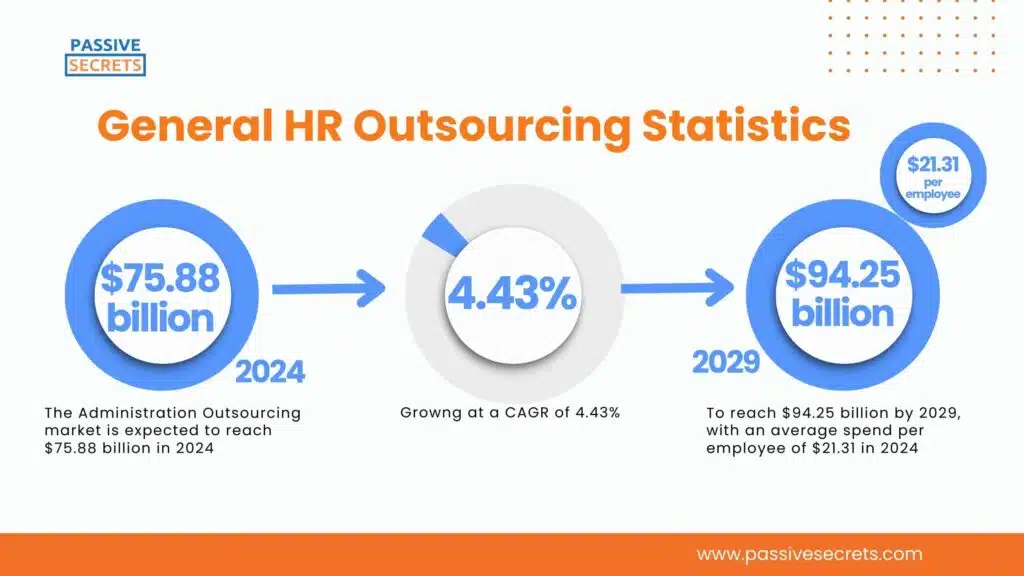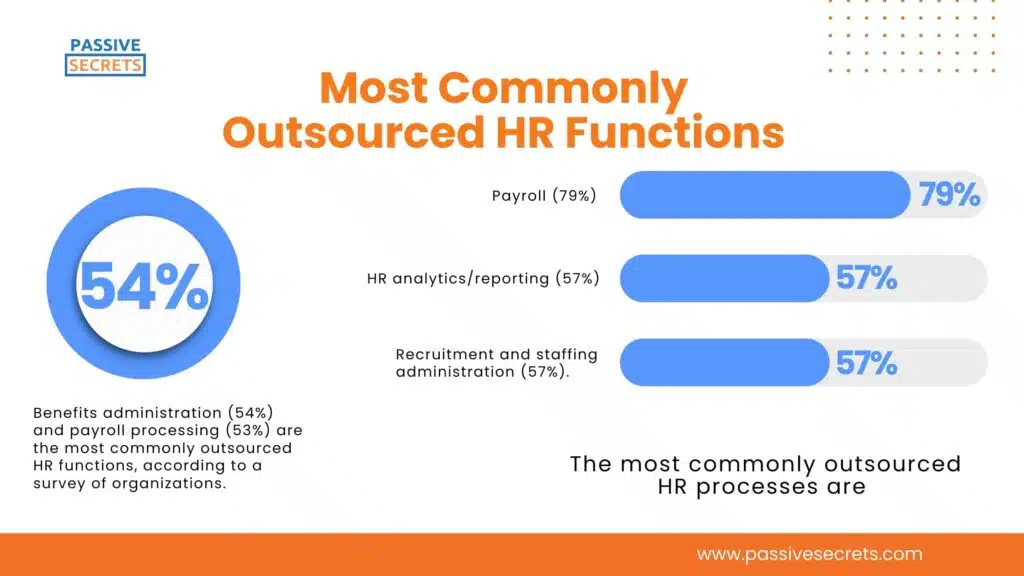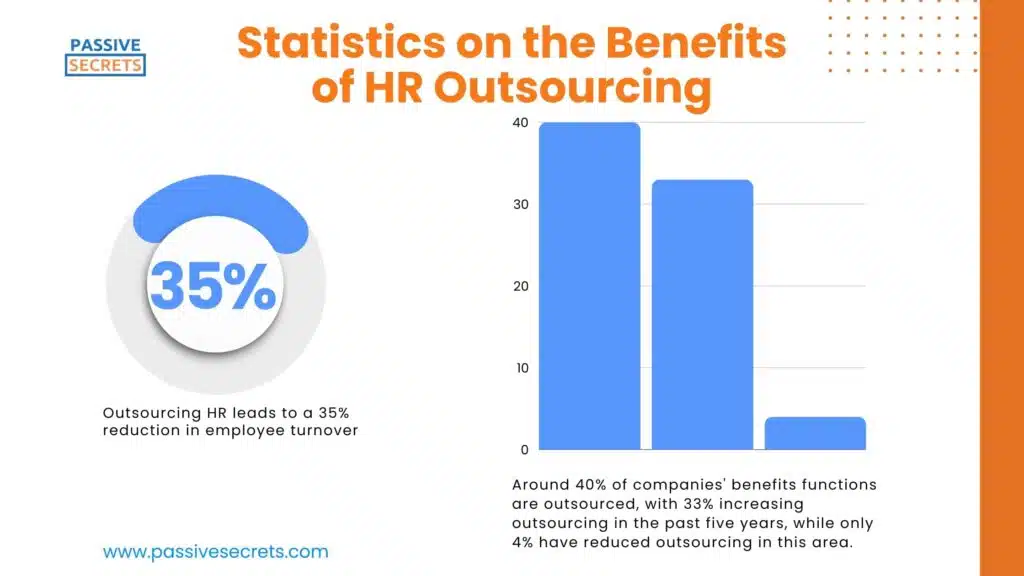
Human Resource (HR) outsourcing is rapidly reshaping the way businesses manage their workforce. By delegating HR functions like recruitment, payroll, compliance, and employee training to specialized providers, companies can focus on strategic growth while optimizing efficiency and cost.
But just how widespread is HR outsourcing, and what impact does it have?
From cost-saving benchmarks to employee satisfaction rates, HR outsourcing statistics highlight its growing influence in organizations of all sizes. Whether you’re a small business aiming to reduce administrative burdens or a large enterprise seeking cutting-edge HR solutions, understanding these trends is crucial to staying competitive.
Let’s dive into the most significant HR outsourcing statistics to see how this transformative practice is shaping the future of work.
Key HR Outsourcing Statistics (Editor’s Pick)
- Benefits administration (54%) and payroll processing (53%) are the most commonly outsourced HR functions.
- Outsourcing payroll offers cost savings, expertise, efficiency, and reduced software maintenance burdens.
- 62% of organizations outsource some or all of their HR functions.
- 73% of organizations outsource payroll, and most are satisfied with their current third-party payroll providers.
- Around 40% of companies’ benefits functions are outsourced, with 33% increasing outsourcing in the past five years.
General HR Outsourcing Statistics
1. The Human Resource Outsourcing Market expanded from $18.65 billion in 2023 to $19.97 billion in 2024 and is projected to continue growing at a 7.59% annual rate, reaching $31.14 billion by 2030. (source)
2. The payroll outsourcing services market is expected to grow by $5.99 billion, at a rate of 4.79% per year, between 2023 and 2028. (source)
3. The recruitment process outsourcing market is projected to grow by $11.41 billion, at an impressive rate of 18.68% per year, between 2023 and 2028. (source)

4. India’s HRO market was valued at $94.36 million in 2022 and is expected to grow at a CAGR of 25.09% from 2023 to 2029, reaching $361.45 million by 2029. (source)
5. The UK’s Human Resources Provision industry has experienced modest growth, with revenue increasing by 0.5% annually over the past five years, reaching an estimated value of £2.2 billion in 2024. (source)
6. 32% of organizations outsource at least one HR function, primarily to streamline administration (51%). (source)
7. The APAC Recruitment Process Outsourcing (RPO) market is expected to grow by $3.59 billion between 2023 and 2028, with a robust CAGR of 21.31%. (source)
8. 75% of Swiss companies manage payroll in-house, yet 67% of them are thinking of outsourcing it to a third-party provider. (source)
9. Swiss companies are dissatisfied with their payroll systems, with only 1 in 3 (33%) expressing satisfaction. (source)
10. 62% of organizations outsource some or all of their HR functions. (source)
11. The life sciences/healthcare and public sectors are less likely to outsource payroll due to their unique payroll requirements and specialized industry needs. (source)
12. Japan’s HR and general affairs outsourcing market reached 11.11 trillion yen (USD 100.1 billion) in FY2022, more than doubling in the past decade, with continued growth expected. (source)
13. The UAE HR Outsourcing Services Market is currently worth $500 million and is projected to grow 6.2% annually from 2024 to 2030. (source)
14. The global HRO solution market is expected to grow from $32.5 billion in 2023 to $54.8 billion by 2032, at a CAGR of 6.1%. (source)
15. The global HR and consulting outsourcing service market was valued at $46.83 billion in 2023 and is expected to reach $73.30 billion by 2032, growing at a CAGR of 5.1% from 2024 to 2032. (source)
The market is predicted to grow due to the increasing adoption of advanced technology, which is expected to enhance efficiency and streamline HR processes, driving demand for outsourcing and consultancy services.
16. In 2024, a US survey found that 56% of training companies outsourced some or all of their workplace training instruction, while 86% kept learner support training in-house. Additionally, none of the companies surveyed outsourced custom content development. (source)
17. The Administration Outsourcing market is expected to reach $75.88 billion in 2024, growing at a CAGR of 4.43% to reach $94.25 billion by 2029, with an average spend per employee of $21.31 in 2024. (source)

18. The benefits administration service market is expected to grow by $144.7 billion, at a compound annual growth rate (CAGR) of 3.09%, between 2023 and 2028. (source)
19. The global Employee Benefits Management market will reach $44.5 billion in 2024 and grow at a 6% CAGR from 2024 to 2031. (source)
The regional market shares are North America (40%, $17.8 billion, growing at 4.2% CAGR), Europe (30%, $13.4 billion), Asia Pacific (23%, $10.2 billion, growing at 8% CAGR), Latin America (5%, $2.2 billion, growing at 5.4% CAGR), and Middle East and Africa (2%, $0.9 billion, growing at 5.7% CAGR). Large enterprises are the fastest-growing segment in this market.
Most Commonly Outsourced HR Functions
20. Benefits administration (54%) and payroll processing (53%) are the most commonly outsourced HR functions, according to a survey of organizations. (source)
21. The most commonly outsourced HR processes are Payroll (79%), HR analytics/reporting (57%), and Recruitment and staffing administration (57%). (source)
22. High-performing HR teams outsource transactional tasks more (45%) and talent management less (22%) compared to peers (29% and 25%). (source)

23. 73% of organizations outsource payroll, and most are satisfied with their current third-party payroll providers. (source)
24. Around 40% of companies’ benefits functions are outsourced, with 33% increasing outsourcing in the past five years, while only 4% have reduced outsourcing in this area. (source)
Statistics on the Benefits of HR Outsourcing
25. Outsourcing payroll offers cost savings, expertise, efficiency, and reduced software maintenance burdens. (source)
26. Outsourcing HR leads to a 35% reduction in employee turnover. (source)

Latest HR Outsourcing Trends for 2025
As the HR outsourcing market is set to grow in the coming years, there are interesting trends to look out for in the industry.
1. Benefits Administration
Benefits administration is about managing employee perks like health insurance, retirement plans, and wellness programs.
In 2025, many companies will outsource this task to save time, cut costs, and stay compliant with changing rules. Although 54% of companies are already outsourcing benefits administration, more companies will join in the coming years.
Outsourcing also improves employee satisfaction by simplifying enrollment and providing better benefits options. It lets HR teams focus on important tasks like hiring and employee engagement.
As workplaces grow more flexible, outsourcing ensures that benefits work for everyone, no matter where they are.
2. Remote Work
Remote work is now a big part of how businesses operate. Hence, more companies will outsource HR tasks like payroll, benefits, and compliance for remote teams. This helps them manage workers across different locations easily and ensures everyone follows the right rules.
Outsourcing also simplifies hiring, onboarding, and managing global talent. It saves time, reduces costs, and makes it easier to support a flexible workforce.
3. Social Media Recruiting
Recruitment processes take time and often cost a lot for companies, especially startups. To save costs, businesses will turn to outsourcing services to recruit top talent faster.
Outsourcing experts use platforms like LinkedIn, Instagram, and TikTok to target the right candidates and promote job openings. This saves time, improves reach, and ensures effective hiring strategies. With professionals skilled in social media trends, companies can attract top talent while focusing on their core goals.
4. Payroll
According to statistics, 73% of organizations outsource payroll, and most are satisfied with their current third-party payroll providers. Payroll outsourcing is an important HR outsourcing trend as businesses face growing complexity in managing employee payments and staying compliant with tax laws and regulations.
Payroll processing involves repetitive, time-consuming tasks like calculating wages, deductions, and overtime. Outsourcing frees up HR teams to focus on strategic initiatives instead of administrative work.
Outsourcing payroll reduces errors and ensures compliance with tax regulations and labour laws. It also eliminates the need for investing in payroll software and training, saving costs.
5. Compliance
In 2025, companies will outsource compliance to handle complex and changing regulations. Outsourcing ensures businesses follow labour laws, tax rules, and safety standards, reducing the risk of fines or legal issues. It also saves time, cuts costs, and supports global teams by managing local compliance needs. This helps businesses stay focused on growth without worrying about legal risks.
Conclusion
HR outsourcing has become an essential strategy for businesses aiming to streamline operations, reduce costs, and access specialized expertise. The statistics presented in this article highlight the growing reliance on HR outsourcing for functions such as recruitment, payroll, and compliance management.
As organizations continue to navigate the complexities of workforce management, outsourcing HR tasks allows them to focus on core business goals while maintaining operational efficiency. Understanding these trends equips businesses with the knowledge to leverage HR outsourcing effectively for sustained growth and success.
FAQs

Other Related Statistics You Should Know:
- 80+ Employee Benefit Statistics: Insights and Trends
- The Most Important Wealth Management Statistics You Can’t Afford to Ignore
- Enterprise Data Management: Essential Statistics and Emerging Trends
- 93 Talent Management Statistics to Help You
- Top Reputation Management Statistics and Trends to Improve Your Brand
- 36 Helpful Social Worker Burnout Statistics To Know
- 100 Business Process Outsourcing Statistics & Facts
- The Top Outsourcing Statistics You Shouldn’t Ignore
- 47+ Shocking 4-day Work Week Statistics To Know
- 105+ Supply Chain Statistics & Facts You Can’t Ignore
- 50+ Interesting Employer Branding Statistics And Trends
- Job Seekers Statistics: Unemployment Rates, Preferences, Challenges
- 95 Interesting Job Interview Statistics and Huge Trends To Know
- 60+ Helpful Change Management Statistics & Facts
- 65+ Employee Performance Management Statistics & Trends
- Workforce Management Statistics: Trends, Insights, & Opportunities
- 73 Revealing Workplace Distraction Statistics
- Workplace Romance Statistics: How Common Is Workplace Romance?
- 40+ Top Workplace Conflict Statistics You Should Know
- The State of Workplace Communication: Key Statistics and Trends
- 55 Workplace Collaboration & Teamwork Statistics

